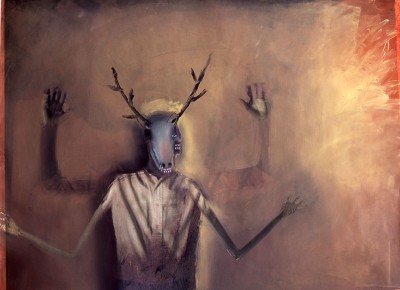Listen to part of a lecture in an art history class.
聽一段藝術史課程。
Professor: All right.
教授:好了。
So last week we started talking about the painters and sculptors who were part of the art movement called Dada.
我們上周開始講了被稱為“達達主義”的藝術運動中的一些畫家和雕塑家。
But I don't want you to think the ideas we introduced last time were limited to painting, sculpture, that sort of thing.
但我不希望你們覺得我們上周講的內容僅限于繪畫、雕塑,諸如此類。
So today I want to move beyond the visual arts and talk a bit about Dada in the performing arts, in theater.
所以今天我想跨出視覺藝術的范圍,講一下表演藝術里(劇院里)的達達主義。
But let's start by reviewing what Dada is. OK?
先回顧一下什么是達達主義,好嗎?
As you will recall, Dada began in Switzerland, in the city of Zurich, in 1916.
正如你們記得的,達達主義起源于1916年,在瑞士的蘇黎世市。
The artists who studied it were reacting against traditional notions of beauty, of reason, of progress, which had been standards of western thought since the 18th century.
這些研究達達主義的藝術家反對關于美、理性和進步的傳統觀點,這些自18世紀以來都是西方思想中的(藝術)標準。
They looked around.
他們將目光投向別處。

And well, I mean, the First World War was raging, so they didn't see much beauty, reason or progress in the world.
而且,我的意思是,當時一戰正處于戰火紛飛之時,所以他們也沒在這世界上看到多少美好、理性或進步。
Instead, they saw a world that was chaotic, random, a world that didn't make sense.
相反,他們看到的世界混亂不堪,充滿變數,整個世界一點都不合理。
And if that's the way the world was, well, they wanted their art to reflect that.
如果這就是世界,他們想要自己的藝術將之反映出來。
So let's... let's review a couple of key ideas that were the backbone of Dada art.
讓我們回顧一下一些主要的觀點,是達達主義的中心。
First, the Dadaists wanted to completely reject the classical idea of art.
首先,達達主義者希望能徹底摒棄藝術的傳統觀點。
Classical ideas like proportion, balance... all the things you think about when you think about great art.
這些傳統觀點包括比例、平衡……所有你在想偉大藝術時能想到的東西。
Great art involved reason, the logic, the beauty that the Dadaists wanted to overthrow.
偉大的藝術包括理性,邏輯與美,而這些正是達達主義者想要摒棄的。
So, well, you know, to a Dadaist, classical artwork was a reflection of outdated thinking!
你明白的,對于達達主義者來說,古典藝術作品是思想過時的表現。
That's why Dadaists created sculptures like the ones we saw last week.
這就是為什么達達主義者創造出我們上周看到的那種雕塑。
Remember the stool with the bicycle wheel mounted on top?
記得頂上裝了自行車輪的凳子嗎?
I wouldn't exactly called that beautiful, would you?
我不會說那很美,你們會嗎?
But of course it wasn't meant to be.
但當然了,那并不是為了美觀。
That was the point!
這是關鍵!
OK. So another key Dada idea we talked about was the embracing of randomness. Right?
好了。另一種我們說的重要達達主義思想是欣然接受偶然性,對嗎?
Uh... if life is random, said the Dadaists, why would we make art that has order and logic?
如果正如達達主義者所言,生活充滿偶然,為什么我們要創造有秩序有邏輯的藝術?
And so we have that collage we looked at, with an artist took different, you know, cut-out squares of colored paper, threw them onto the canvas, and wherever they landed, that was the composition of the work!
所以我們就有了我們所見的拼貼畫——一位藝術家拿了各種剪成方形的彩紙片,把它們扔到畫布上,它們的落點就構成了一幅畫。
Another favorite of the Dadaists was something called chance poetry.
達達主義者的另一項最愛是叫隨機詩歌的東西。
A chance poet would pull words out of a hat and that would be... that would make up the poem!
隨機詩人會從帽子里抽取單詞,這……這就成了一首詩!
And this idea of chance and randomness was a key element of Dadaism because the whole world seemed so random to them.
而這種隨機性和偶然性的思想是達達主義的重要元素,因為對她們來說,整個世界都充滿隨機性。










